The black snakes on this list are often confused with each other, such as the black racer with the black rat snake. One of the snakes on this list is dangerous because it is highly venomous, but it doesn’t seek out humans.
Snakes have overlapping territories, so there are undoubtedly snakes that look like each other in the same state. It’s good to be able to tell the snakes apart because they not only live in nature, some happily live in human developments.
Out of the hundreds of different kinds of snakes in the United States, what black snakes are there in Tennessee? We’ll look at 7 together.
Black Snakes in Tennessee
Here’s a list of some of the black snakes in Tennessee:
- Red-Bellied Mud Snake
- Northern Black Racer
- Eastern Black Kingsnake
- Northern Ringneck Snake
- Northern Cottonmouth
- Eastern Hognose Snake
- Black Rat Snake.
1. Red-Bellied Mud Snake
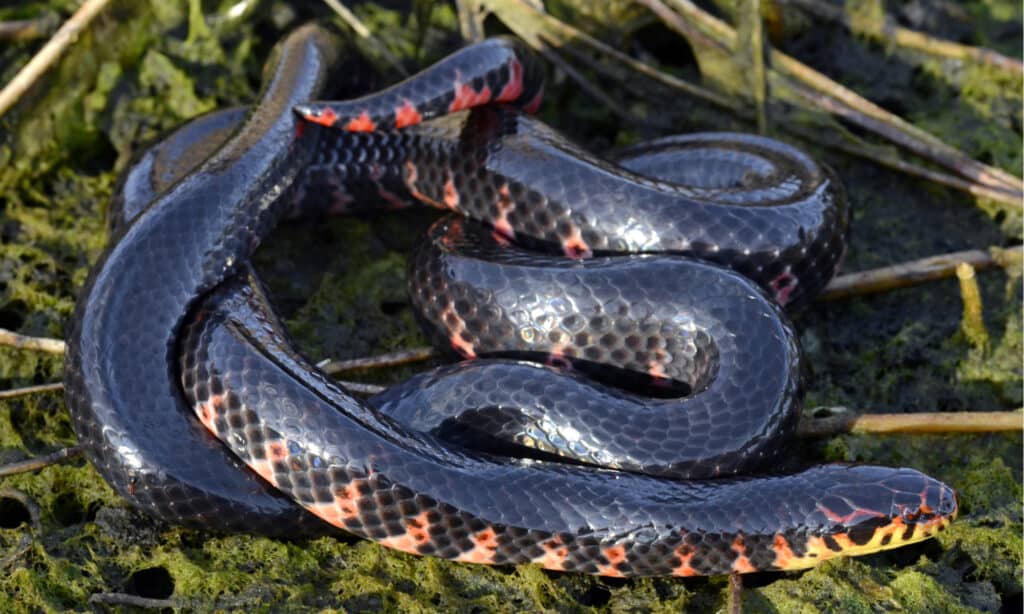
Red-bellied mud snakes are commonly spotted around Reelfoot Lake in Tennessee.
©Patrick K. Campbell/Shutterstock.com
These snakes average at about 4 feet in length, and they’re thick snakes. They’re nonvenomous, and while they’re not all black, they’re mostly glossed black with a checkered underside.
They like to hang out in muddied stagnant water along rivers and streams and are best spotted in West Tennessee around Reelfoot Lake.
Red-bellied mudsnakes are almost fully aquatic. They primarily chow down on elongated and eel-shaped salamanders called lesser sirens. They enjoy heavy rains most as it expands their habitat.
2. Northern Black Racers
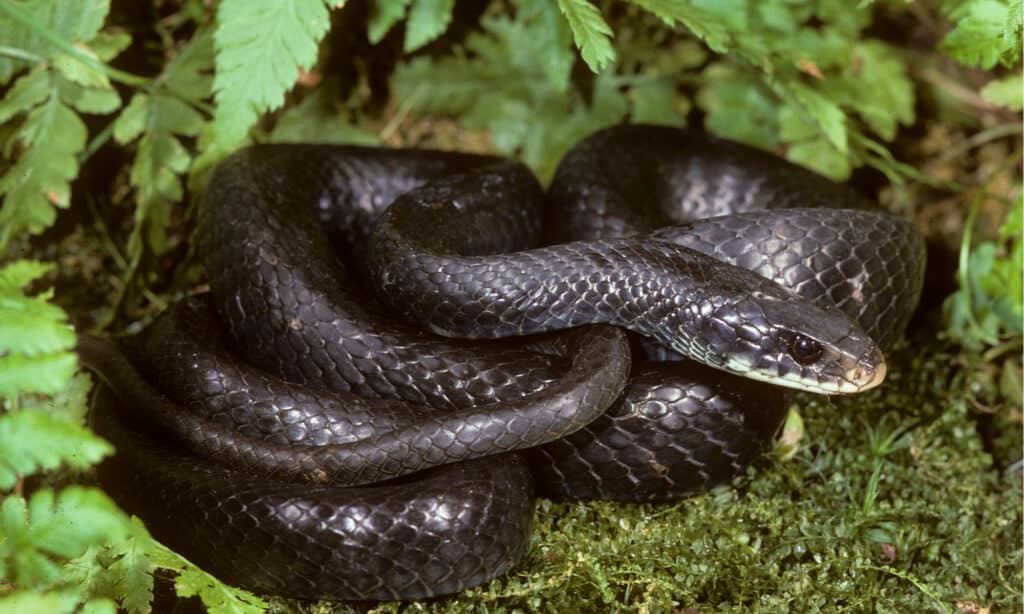
Northern black racers in eastern Tennessee shake their tail like a rattle when threatened.
©Breck P. Kent/Shutterstock.com
This snake is found throughout eastern Tennessee, and it’s one of two kinds of racers found in the state. It is almost always matte black with a slightly lighter underside ranging from blues to greys. Its chins are off-white.
Northern black racers will defend themselves if threatened, though they’re nonvenomous. They enjoy living in suburban areas, open woodlands, and fields. If cornered, they shake their tail in leaves to mimic a rattle and defend themselves by striking.
Northern black racers prefer fields, meadows, roadsides, and lightly wooded areas. They’re not keen on heavy forests. They make good use of suburban areas like road divides that have grass that’s cut but otherwise is undisturbed.
It hunts during the day and eats various foods, including frogs, toads, small birds, chipmunks, mice, rodents, and invertebrates. This snake isn’t a constrictor; rather, it holds its prey down and swallows it whole.
3. Eastern Black Kingsnakes

Almost all of Tennessee is home to the eastern black kingsnake.
©Matt Jeppson/Shutterstock.com
This snake can be found in most of the state of Tennessee. It’s a constrictor that feeds on rabbits, rodents, and other small animals. It likes farmlands, suburbs, and forests. It can be found in swamps and near streams, but it prefers to spend its time on land.
Kingsnakes also eat other venomous snakes, and a study of juvenile king shakes shows that they’re able to pick up on the chemical cues from the skins of the snakes they want to eat.
It’s not completely black as it’s usually speckled with a light color. Sometimes it’s banded instead of speckled. However, this species has colorations that vary widely, and some individuals are all black.
4. Northern Ringneck Snakes
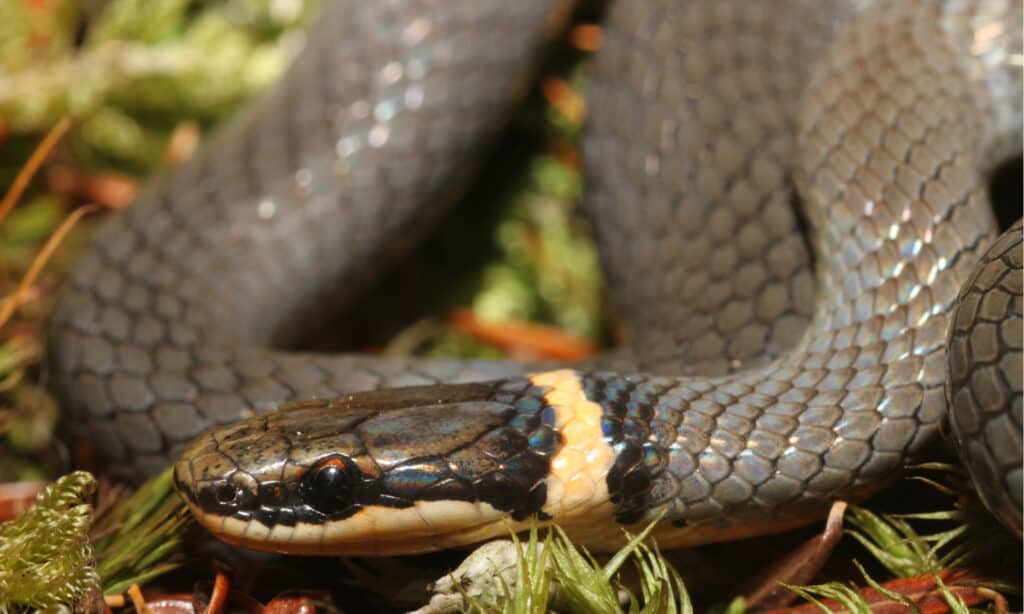
Northern ringneck snakes can be found all over Tennessee.
©/Shutterstock.com
As one of the smallest snakes in the world at 9.8 inches, the ringneck snakes aren’t totally black. They’re not only small lengthwise, but they’re also as thin as a pencil.
Some of them have gray bodies, while other individuals have black bodies. They all have a characteristic color band right where their neck starts, and their bellies match this ring of color.
Ringneck snakes are often kept as pets because they’re relatively docile, and they have the aforementioned really cool ring of color on their necks. They’re slightly venomous but not enough to do any harm to humans. This venom is meant to subdue their prey.
The prey the ringneck snake eats is only large enough for them and isn’t something huge in comparison to this petite snake. It likes to dine on salamanders, insects, small frogs, slugs, beetles, and earthworms.
The Northern ringneck snake is endemic to North America. There are a lot of them around, but they’re secretive, so they’re not often spotted in the wild. They can be spotted nesting together occasionally; females will gather in groups to lay their eggs.
5. Northern Cottonmouth — This One Is Dangerous!
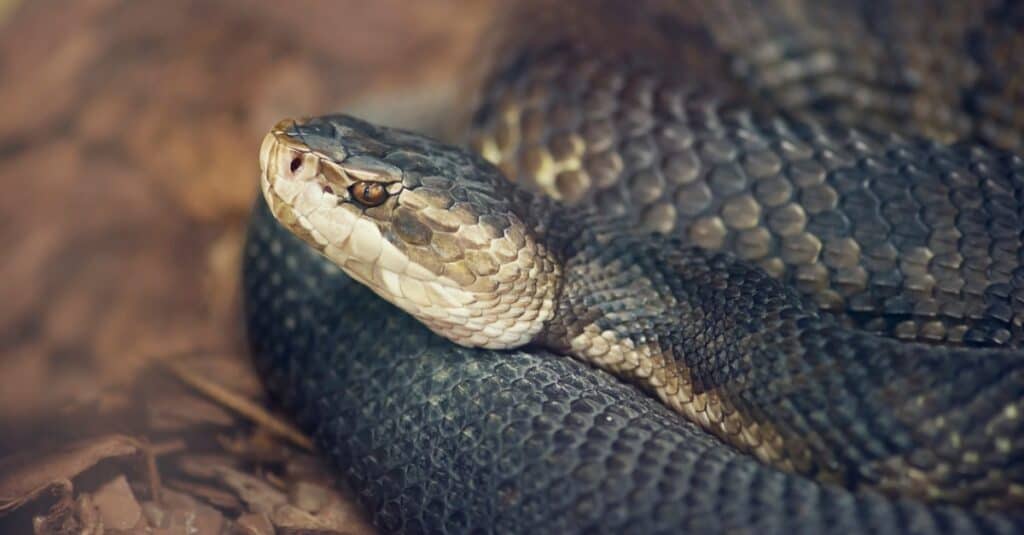
Cottonmouths are the only venomous water snake in Tennessee.
©iStock.com/Saddako
Cottonmouths are venomous aquatic snakes and are the only venomous water snake in Tennessee. Luckily, they only inhabit the west part of the state.
They’re also known as water moccasins, and they like to spend their time in or near slow-moving water, such as river floodplains, wetlands, and lakes. They’re called cottonmouths from the white interior of their mouths that they bare open when threatened or ready to strike.
While most individuals are dull greyish or brown, the older snakes are almost black. While these snakes do have potent venom, they’re not much of a threat to humans because they’d rather flee.
6. Eastern Hognose Snake
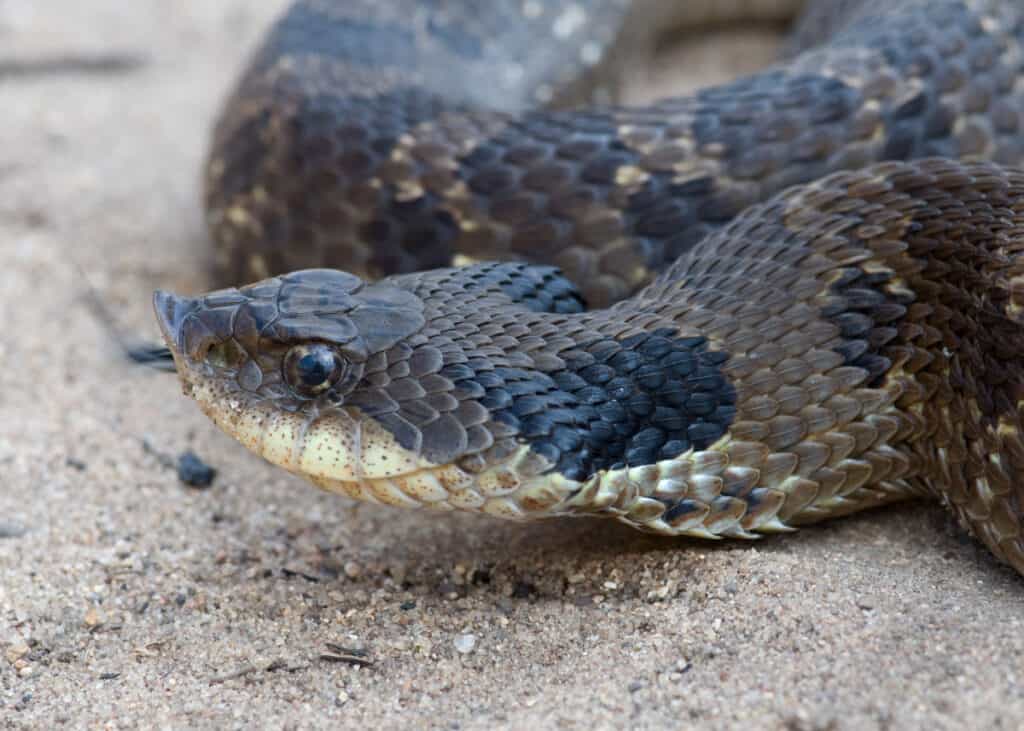
While Tennessee is host to hognose snakes in various colors, a lot of them are all black.
©Gerald A. DeBoer/Shutterstock.com
This is another snake on our list that isn’t exclusively black, though enough individuals are black that they’ve made it on this list. It can be found all over Tennessee.
Their rostral scale, or nose scale, is upturned in such a way that it looks like a cute pig snout. Their snout allows them to root around in ground debris and find or make burrows when it’s time for brumation.
These snakes are common in different regions in various colors, and they’re often kept as pets. In the pet industry, there are a variety of different morphs covering a gamut of colors.
7. Black Rat Snake
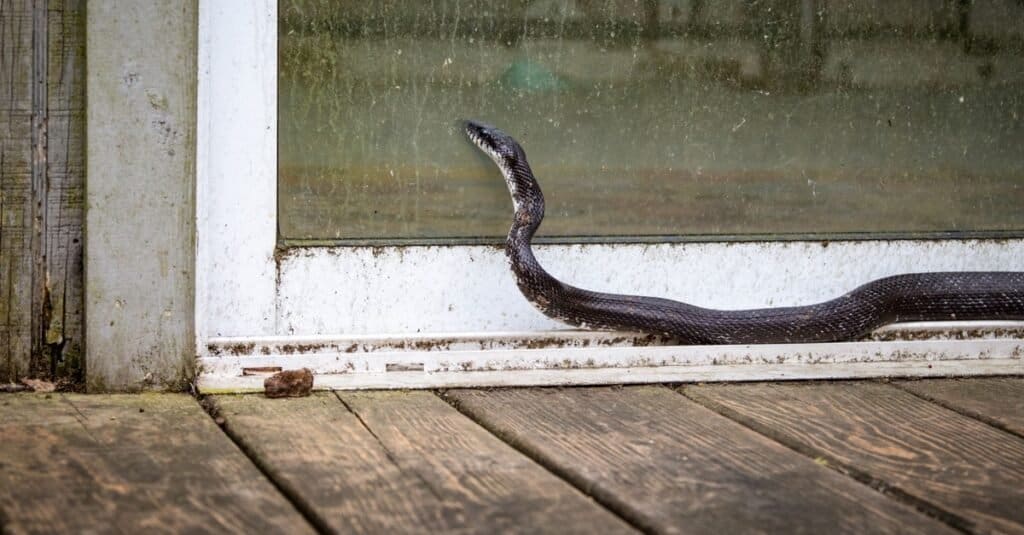
Black rat snakes are found east of the Mississippi River.
©Kyla Metzker/Shutterstock.com
These snakes are almost always black though some have a greyish body with black stripes. They’re one of the largest snakes in Tennessee, averaging under 6 feet in length.
When threatened, they vibrate their tail to mimic a rattlesnake, just like many other snake species. They’ll release a disgusting musk if handled. Rat snakes become aggressive if cornered.
They hang out in a variety of habitats east of the Mississippi River. Black rat snakes spend a lot of their time up in trees, and they’re great climbers. It’s also a decent swimmer.
They’re constrictors, so they squeeze their prey to death. Their prey is rodents and other small mammals. They’ll also eat birds and eggs.
Other Snakes in Tennessee
What other snakes are you likely to encounter in the Volunteer State?

Copperheads are venomous and can be found throughout Tennessee
©iStock.com/David Kenny
Copperheads: These snakes recognizable by their coppery scales interspersed evenly with reddish brown crossbands, can be found throughout the state. Copperheads are capable of growing to 36 inches and can also be recognized by their large triangular heads. They are venomous and also have facial pits.
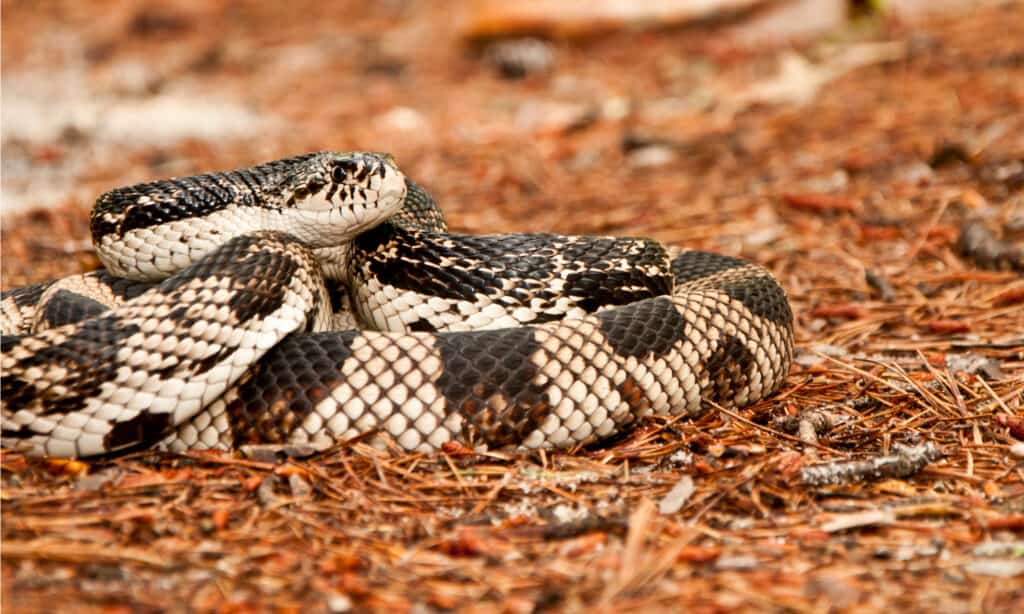
Pinesnakes are large and bulky and are capable of growing to 66 inches
©Jay Ondreicka/Shutterstock.com
Pinesnakes: These reptiles are covered in whitish or yellowish scales which are also patterned with dark brown or dark red patches on their back and sides. They are large and bulky with a maximum length of 66 inches. They are found throughout Tennessee except for parts of the east, most of the west, and its Central Basin.
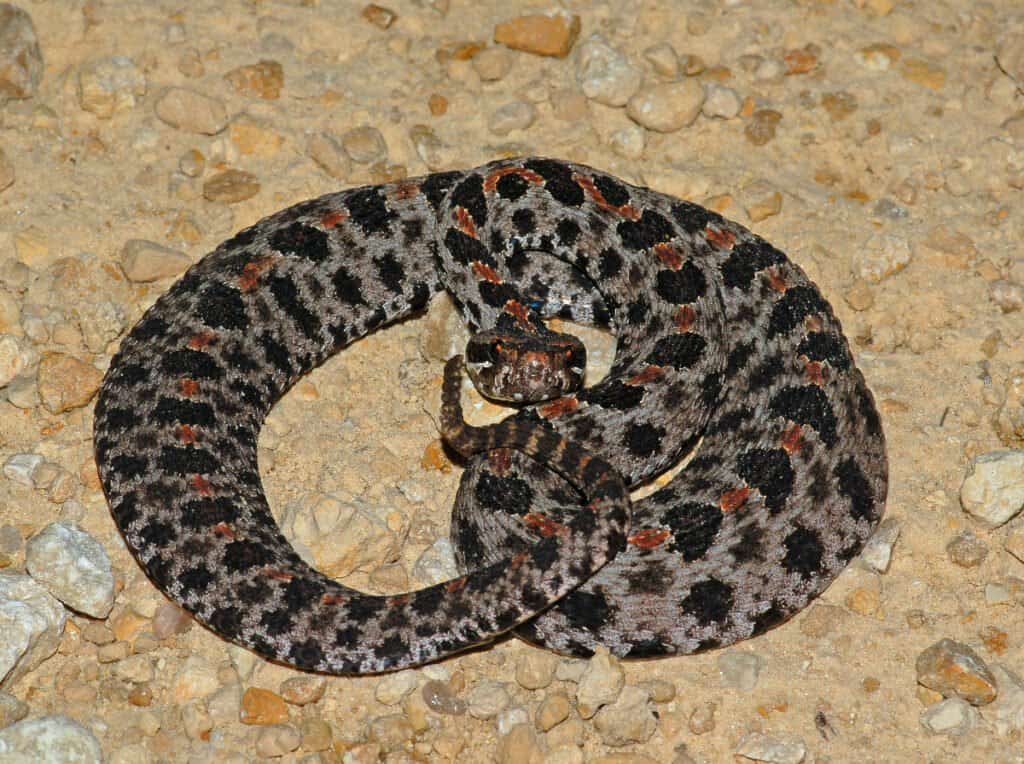
Pygmy rattlesnakes are capable of growing to 20 inches
©Gerald A. DeBoer/Shutterstock.com
Pygmy Rattlesnakes: This species is found around the western part of the Highland Rim and can be recognized by alternating rods of dark brown and lighter brown against a grey background. It is capable of growing to 20 inches at the most.
Other Reptiles in Tennessee
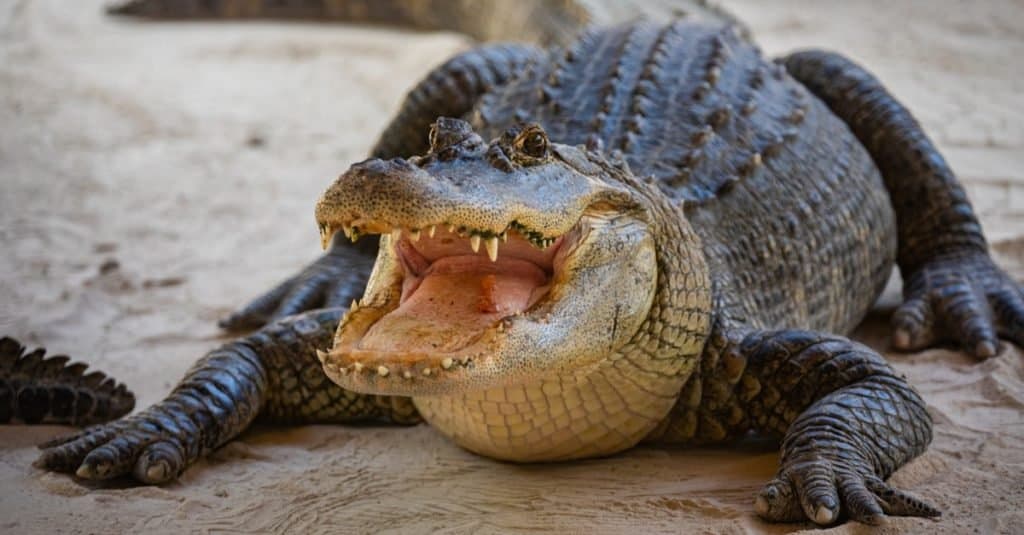
Alligators
have been spotted on several instances in Tennessee, proof they are moving in from southern regions
©Mia2you/Shutterstock.com
Alligators: Although these giant reptiles are more likely to evoke thoughts of Louisiana and Florida, several of the lumbering carnivores have decided they quite like it in southwest Tennessee. Their presence has been verified by several confirmed sightings, proof that they are slowly but surely making Tennessee a part of their natural range.

Box Turtles can be found throughout Tennessee and can be recognized by their patterned shells
©samray/Shutterstock.com
Eastern Box Turtles: These reptiles known for their shells which seem painted with yellowish motifs against a darker back can be found throughout Tennessee. They are rather small-sized and are capable of growing to half a foot at the most. Females have brown eyes while those of males are red. The species is omnivorous with its diet consisting of grass, fungi, fruit, insects, invertebrates, and reptiles.
What State Has the Most Snake Bites?
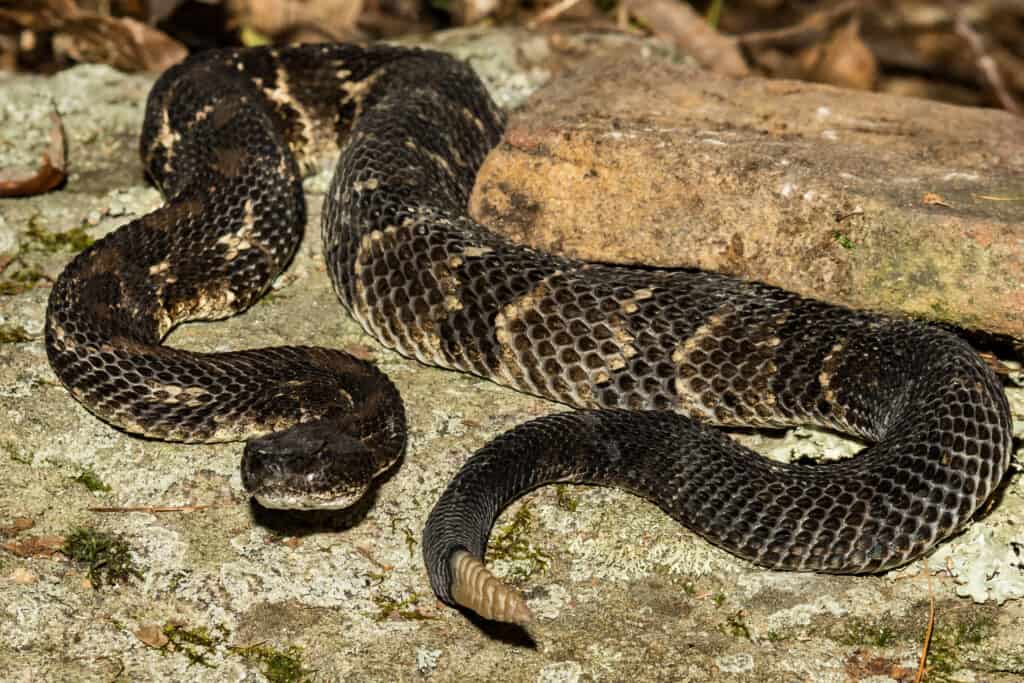
The venomous timber rattlesnake is among the snakes responsible for snake bites in North Carolina.
©iStock.com/JasonOndreicka
In Tennessee, there are an estimated 50 snake bites per year. That’s not a whole lot if you stack it up against the states that rank highest in reported snake bites annually. So what state ranks the highest in snake bites? That would be North Carolina. This southeastern state’s bite rate is 157.8 bites per million population per year. How does that average out? Well, the population as of 2021 was a little over 10 million (10.55 to be exact). If we were to just figure it off of 10 million, that would mean that there are roughly 1,580 reported snake bites per year.
The top 6 states for reported snake bites are as follows:
- North Carolina–157.8 bites per million
- West Virginia–105.3 bites per million
- Arkansas–92.9 bites per million
- Oklahoma–61 bites per million
- Virginia–48.7 bites per million
- Texas–44.2 bites per million
In North Carolina, there are 6 different kinds of venomous snakes: copperhead, cottonmouth, timber rattlesnake, pigmy rattlesnake, eastern diamondback rattlesnake, and eastern coral snake. In 2019, 92 people were bitten by venomous snakes in that state.
Summary of 7 Black Snakes in Tennessee
Here’s a recap of the 7 black snakes present in the state of Tennessee that we took a look at:
| Index | Species | Location |
|---|---|---|
| 1 | Red-Bellied Mud Snake | West Tennessee around Reelfoot Lake |
| 2 | Northern Black Racer | Eastern Tennessee |
| 3 | Eastern Black Kingsnake | Almost throughout Tennessee |
| 4 | Northern Ringneck Snake | Throughout Tennessee |
| 5 | Northern Cottonmouth | Western Tennessee |
| 6 | Eastern Hognose Snake | Throughout Tennessee |
| 7 | Black Rat Snake | East of the Mississippi River |
Discover the "Monster" Snake 5X Bigger than an Anaconda
Every day A-Z Animals sends out some of the most incredible facts in the world from our free newsletter. Want to discover the 10 most beautiful snakes in the world, a "snake island" where you're never more than 3 feet from danger, or a "monster" snake 5X larger than an anaconda? Then sign up right now and you'll start receiving our daily newsletter absolutely free.
Thank you for reading! Have some feedback for us? Contact the AZ Animals editorial team.








